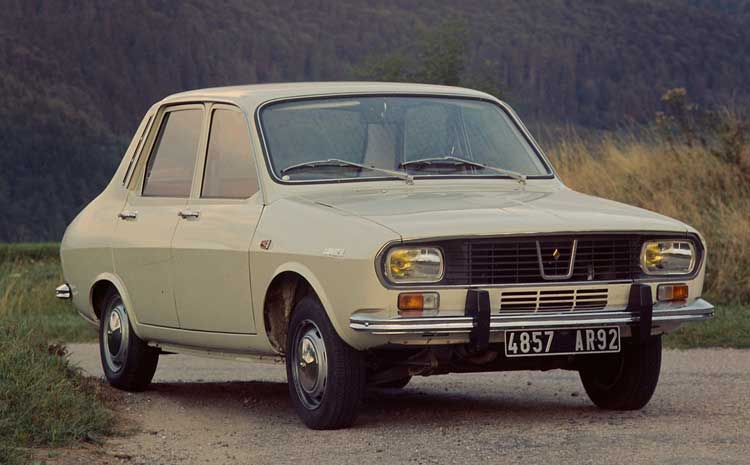Renault 12
This Gallic wedge brought a touch of ooh-la-la to drab 1970s Britain. Even reps loved it, says Andrew Roberts

In the Eighties, shoppers at the Knightsbridge Sainsbury's were often treated to the sight of a black diplomatic car disgorging several menacing-looking occupants, all of whom had one target; dog biscuits. The dark-suited gentlemen belonged to the Romanian Embassy and it was their duty to buy food for the dog of their beloved leader, Nicolae Ceausescu.
What really lent the whole scene a farcical note was the embassy car – a Dacia Denem, which most Britons would have recognised as a Renault 12 clone.
When Renault embarked on project 117 in 1965, the idea was a car that had to be easy to produce, so it could be made all over the world. It had to be reliable for export and comfortable for France. It should be able to carry multiple variations. And the 12 would be front-wheel drive, with the longitudinally mounted engine ahead of the front wheels.
All this meant a prospective buyer would be faced with the 16's dash-mounted handbrake, a four-on-the-floor shift, the 1.3-litre engine from the R8 and styling that could only be described as idiosyncratic.
When the 12 debuted at the 1969 Paris show, some purists bemoaned the fact that Renault's original plans – a boot-mounted spare wheel; twin headlamps to the off side, with a single unit to the left – were abandoned in the face of marketing advice. Still, the 12 is one of few family cars that could never be called bland.
The four-door body was proudly described by Renault as "arrow-like", and for a model meant to rival the Citroë* Ami and the Simca 1100, it was surprisingly large – it was longer than a Mk 2 Cortina. But then, Renault's goal was to produce a sizeable family car of modest but respectable performance.
The 12 was launched in the UK in 1970, in time for a new era of imported cars being used by the fleet market. In the 1960s, Renault's UK sales had been healthy but it was the 12 that propelled La Régie to becoming the country's major car importer in the new decade. The Renault's robustness was a bonus; it even had a starting-handle bracket.
The 12 was also one of the most comfortable cars in the Escort sector. The bench seat of the 12L was sheer decadence, bettered only by the separate reclining articles in the 12TL.
The Renault 12 wasn't faultless – the steering was heavy, the handbrake was spectacularly awkward, it was rust-prone, and the performance wasn't great – but it was a car to be aspired to. Throughout the 1970s, Renault's UK brochures featured the tempting combination of vibrantly coloured 12TLs being lusted after by male models, all of whom hailed from the Englebert Humperdinck/Peter Wyngarde school of grooming.
From the five-door 12 Estate, to the 12TS with its foglamps and head restraints, there was a 12 for every taste, although the ultimate variant was never officially imported into the UK. The 1970 12 Gordini used the 1.6-litre engine from the 16TS, with twin double-barrel Weber carburettors, all-round disc brakes and five gears – Escort RS1600 salesmen were very thankful that a 125bhp 120mph version of the Renault 12 wasn't available with right-hand drive.
But the 12 was always meant to be a "world car", and it was built in Spain and Argentina. In Australia, the 12 was assembled in Melbourne until 1980. Meanwhile, Oyak-Renault of Turkey produced its own version until 1998. Ford of Brazil made the Corcel, a not unattractive combination of Mk 1 Escort styling with 12 underpinnings.
But the most infamous overseas 12 was produced by Dacia of Romania from 1969 onwards, with the 1300 for the hoi polloi and the 1300 Super Luxe (radio and twin wing mirrors) for the party elite. Dacia became fully independent of Renault in 1978 and attempted to sell "The Very Acceptable Dacia Denem" to a very unaccepting British public.
Meanwhile, the French-built 12 gained a minor facelift in 1975, together with the welcome option of cloth upholstery (a real sign of distinction in British suburbia in the late 1970s) prior to its replacement by the terminally bland 9 in 1981.
By the end of the 1980s the 12, together with the Fiat 127, the Datsun 160J Violet, the Simca 1204 and the Mazda 1300, seemed to be another example of a once-common import starting to vanish from the bargain section of Exchange & Mart.
Even Romanian production ceased in December 2006, in the face of EU legislation. Still, Romania gave the 12 its most recent bout of fame in the form of a bullock-driven taxi in Borat: Cultural Learnings of America for Make Benefit Glorious Nation of Kazakhstan.
But a vehicle that sold 2.5 million units deserves a more dignified memorial. In Britain, there are thousands of retired sales reps who fondly remember the day they handed back the keys to a Hillman Avenger GL to the fleet manager who then issued them a long-awaited midnight blue 12TS. Yes, now they had it all: the Harry Fenton suit, the hire-purchased ceramic hob and, most important, a reliable car with head restraints as standard. Who could possibly have asked for more?
Subscribe to Independent Premium to bookmark this article
Want to bookmark your favourite articles and stories to read or reference later? Start your Independent Premium subscription today.

Join our commenting forum
Join thought-provoking conversations, follow other Independent readers and see their replies